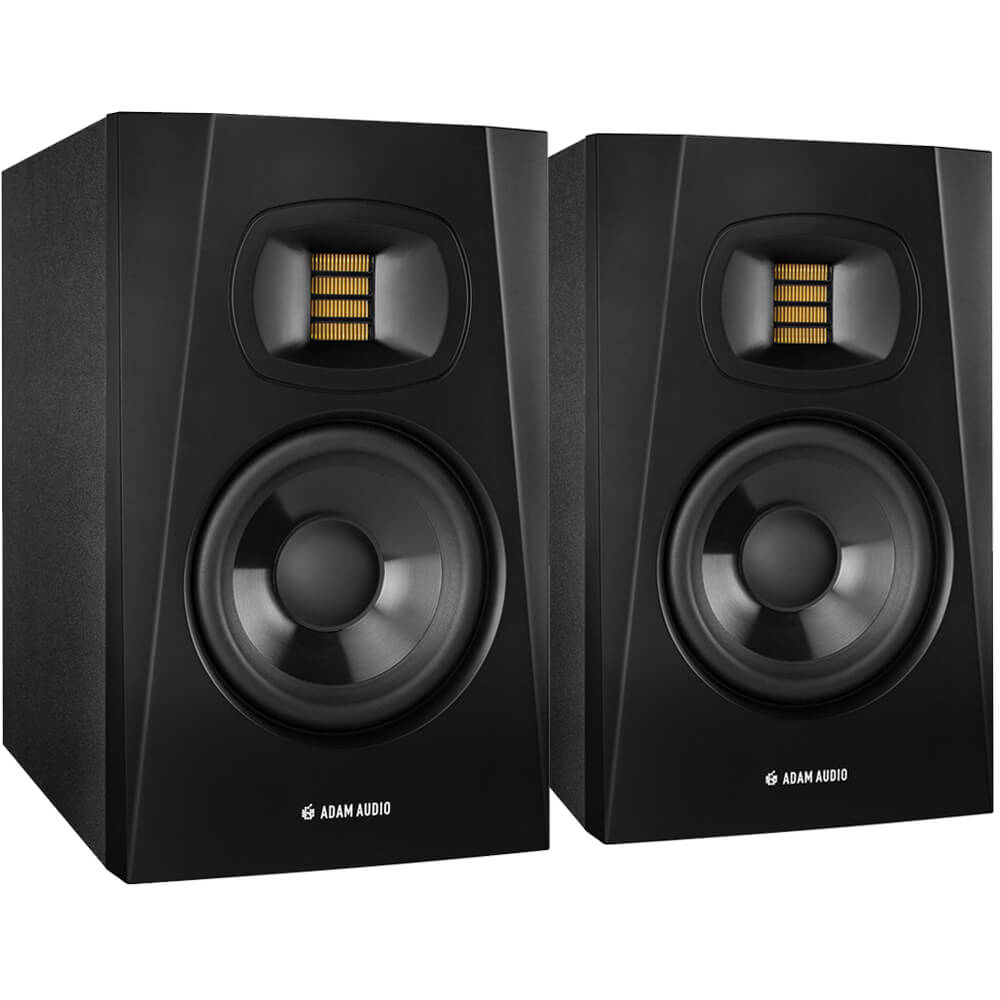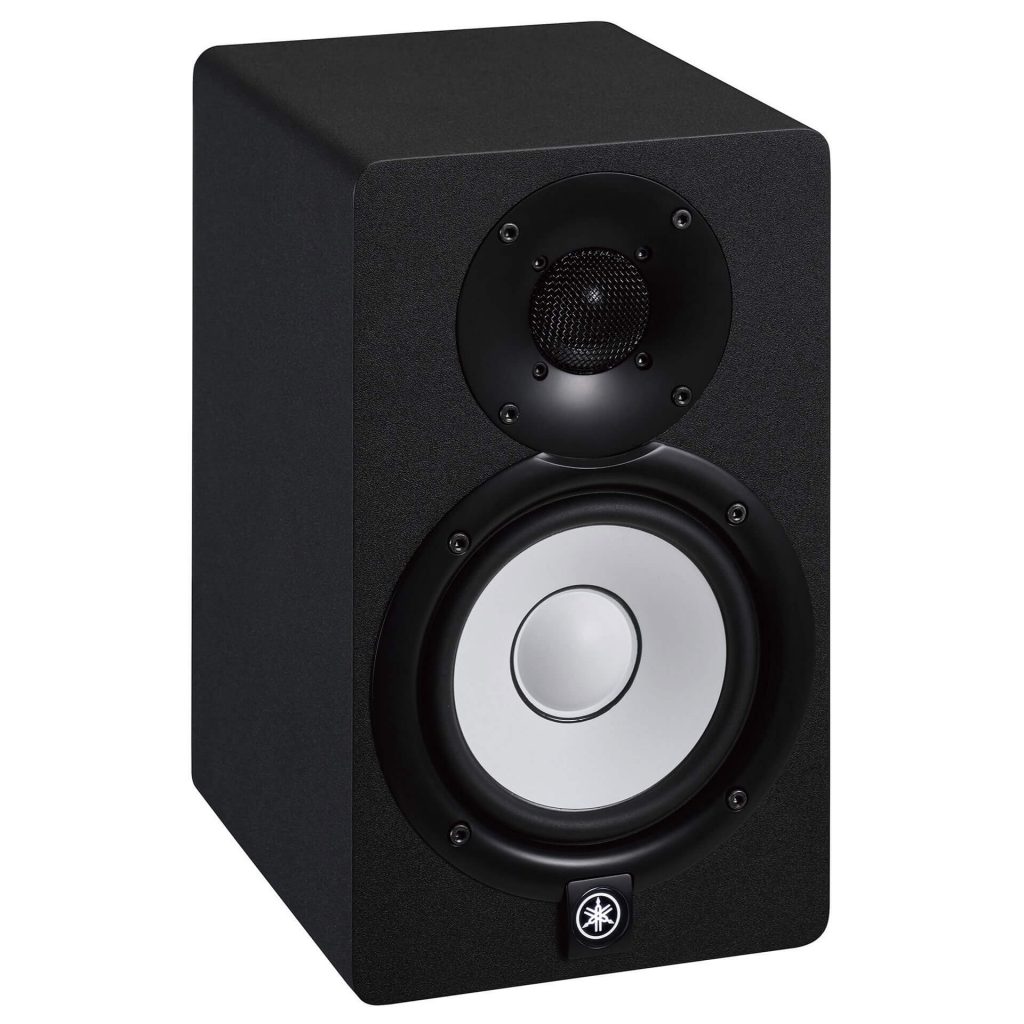Top 5 Affordable Studio Monitors for Epic Sound
One of the first things that budding musicians want is a sweet pair of studio monitors. Monitors give us a better picture of our stereo field and level, as well as punchier bass compared to most affordable headphones.
We’re talking about 5-inch studio monitors here, so the bass won’t be as amazing as, say, 8-inch monitors. But that doesn’t mean you’re not getting any bass for your buck. If low-end bass is important to you and your style of music, look into getting a sub.
With that said, let’s dig into our favourite affordable studio monitors!
ADAM Audio T5V – $344.50

A 5″ woofer like none before it. And, even better, an affordable 5″ woofer that exceeds the threshold of human hearing with a frequency response of 45 Hz – 25000 Hz.
Adam’s unique U-ART (Unique Accelerated Ribbon Tweeter) has never failed to deliver a pristine sound inside a small casing. As you’d expect, the T5V studio monitors here are no different.
The Class-D powered two-way design with a rear-ring bass reflex is the smaller of the new T Series models, but it’s still mighty. If you’re unfamiliar, Class-D amps have the least efficiency but the highest audio fidelity.
Although these are some of the more expensive monitors on our list, they’re in the top slot for a reason. With 25cm between the wall and the monitors (to account for the rear bass port) and the utilisation of the low-frequency EQ (which offers either -2dB, 0, or +2dB), these monitors are fit for all studios. Of course, there’s a high-frequency EQ that offers -2dB, 0, or +2dB too!
Adam tunes their top end to perfection and the T5V’s are no different. You could get used to any of the three EQ settings.
Placed horizontally, the T5V’s offer a broad monitoring sweet spot like the Adams that have come before (such as the S2V’s). Horizontal placement offers a better sweet spot than vertically, but given the perfection of the sweet spot, we think we can forgive Adam for that.
They’re quite narrow for monitors with a 5″ woofer. The unit itself is quite a deep one, but this doesn’t stop the speakers from feeling compact and full of hardware.
Packing both balanced XLR and unbalanced phono/RCA inputs with a selector switch-wise, given the target market.
There are some slight drawbacks though. The green LED power light is on the back which seems a little unneeded. But at least it’s not cramping the style of the front of the speaker.
The low-mid range is slightly dipped compared to the likes of a more expensive monitor. But this problem isn’t a deal-breaker. Should you want to colour those areas in with sound then a sub will do you perfectly!
Yamaha HS5 – $393.66

A truly renowned pair of affordable monitors. They fit easily in any room with dimensions of W 6.7″ x H 11.25″ x D 8.75″, only weigh 11.7 pounds, and will only cost your pocket.
The HS5‘s feature a Room Control filter that allows for 2 dB to 4 dB attenuation of low end below 500 Hz. Room Control compensates for any speaker-boundary effects that may lead to a muddy low-frequency response when the monitors are close to a wall. Their 5″ woofers and 1″ dome tweeter draw power separately to make these monitors as powerful as you need for a home studio. A 45W amplifier provides power for the woofer, while a 25W amp powers the tweeter.
Both balanced XLR and 1/4″ TRS inputs allow for you to choose between balanced and unbalanced connections, but we recommend keeping it balanced to avoid interference such as ground loops.
The monitor’s frequency response sits at 74Hz to 24kHz, with 10dB down points at 54Hz and 30kHz to keep the low end tidy. The response does start to drop off below 200Hz. It recovers itself around 80Hz before tailing off again.
There’s about 2dB of dip between 7kHz and 10kHz understates vocal sibilance (s’s and t’s), but there’s about a 3dB peak in the response between roughly 650 Hz and 1,300Hz. Be mindful that this may make lead vocals sound more forward than they actually are in the mix.
Rokit KRK RP6G3 – $320.50

Very similar to their older siblings, the KRK 5’s, the frequency response of the RP6G3 is 20Hz – 35kHz with a more defined mid-bass range. These Rokit KRK’s have 73 watts of power, utilising A/B high power amplifiers. These are some very loud monitors!
The RP6’s come with RCA, 1/4″ TRS & XLR inputs. We recommend sticking to TRS or XLR inputs and keeping your entire signal chain balanced to avoid ground loops and hums.
To accommodate for your room, a big front-firing resonance port (the big hole) at the bottom allows for a rich low end to punch through. However, due to their size, the bass response on the RP6’s is not amazing…
These monitors feature both a low and high-frequency adjustment, as well as the volume knob. For example, should you have them on your desk you could attenuate the low frequency to stop your desk from resonating. Acoustic problems are further reduced by the curved sides at the front of the speaker!
M-Audio BX5-D3 – $257.45

The BX5 monitor range by M-Audio has long established itself as an affordable option, being the first choice amongst newcomers.
The D3 range is no different as it inherits so many of the characteristics of the older models. Including the one-inch silk-domed tweeter and the five-inch woven Kevlar woofer (which are both magnetically shielded). Not only this but the vinyl-laminated MDF cabinet too!
The rear bass port enhances the low-end projection, as well as the rear volume control! Both XLR and TRS inputs are available, and a team effort of acoustic space bass settings of Flat, -2dB and -4dB to compensate the position of the monitors.
M-Audio has upgraded the Class AB bi-amplification across the D3 range, and they’re now capable of delivering both 60 and 40 Watts to the LF and HF units, with the frequency cross over between woofer and tweeter at 2.5kHz!
Presonus Eris E3.5 – $105.43

A small but mighty pair of speakers that have developed a reputation for themselves. Not only for music production but content creation too!
It may be a smaller monitor than the likes of the 4.5 (by one inch, of course), the Eris 3.5 still includes some of the expert features that the larger speakers in the Eris series. Housing a Kevlar driver for some punchy playback, as well as a vinyl-laminated fibreboard enclosure for lower vibration and distortion.
The 3.5s feature their amplifier in the left speaker. The right is then powered via a connecting power cable to the right speaker. This is often the norm for smaller speakers, but it’s very easy to set up. As wells as this, the left speaker has both high and frequency cut and boost options to help you get the monitors working with your room.
With both TRS and RCA inputs, as well as a headphone output and mini-jack for small devices like smartphones, make the E3.5 monitors a practical tool for both listening to music and production! There’s no balanced XLR input like on bigger Eris monitors, though. These monitors were specifically designed for desktop use in home studios.
A bonus is the front panel controls like volume and headphone level for real-time adjustments to get the most out of your listening experience.
Of course, ‘3.5‘ refers to the size of the woofer. Although it is only a small woofer, the low end does extend to 80 Hz. The low-end response is surprisingly punchy due to the build of the speaker and is certainly enough to give you a good idea of what’s going on in your DAW when nearfield listening.
On the other hand, the high end really does find its way through the sound field. Perhaps a little too much on occasion. But there is the high-frequency control on the back of the left unit tame and reduce the highs they’re too harsh.
To get a pristine sound from your studio monitors, you need great sounding samples.
We at Mixxed work daily to make sure you have the best sounds at all times. On our platform, you’ll have access to thousands of samples that you can browse, download and keep forever – for less than $3 a month!
Our catalogue is growing daily as we work with more and more leading sample creators and labels to bring you the finest sounds that are fit for countless genres.
Sign up today to find your sound!
